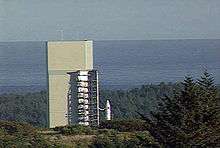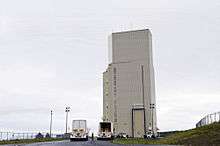Pacific Spaceport Complex – Alaska


The Pacific Spaceport Complex – Alaska (PSCA), formerly known as the Kodiak Launch Complex, is a dual-use commercial and military spaceport for sub-orbital and orbital launch vehicles.[1] The facility is owned and operated by the Alaska Aerospace Corporation, a public corporation of the State of Alaska,[2][3] and is located on Kodiak Island in Alaska.
The spaceport opened in 1998 and has supported 17 launches, most of those for the U.S. government. The site was closed for two years following a launch failure that did significant damage to parts of the spaceport. It reopened in August 2016.
History
Following the incorporation of the Alaska Aerospace Development Corporation in 1991 by the Alaska state legislature, plans were begun for the spaceport, known during development as the Alaska Orbital Launch Complex. Construction on the site began in January 1998, and the first launch took place in August 1998 from temporary accommodations at the site.[4]
After a launch failure in August 2014 damaged the launch tower, payload processing facility and integrated processing facility,[5] Alaska Aerospace made plans to repair and upgrade the facilities to support larger rockets, but Governor Bill Walker stopped work in December 2014 as part of an order to address a state budget shortfall.[6] Repairs to the facility were funded by state insurance at a cost of US$26-29 million.[7] During efforts to repair the facilities, the spaceport was formally renamed to "Pacific Spaceport Complex – Alaska" in an announcement made on April 14, 2015.[8] The facility was formally re-dedicated on August 13, 2016, to celebrate the completion of repairs.[1]
In mid-2016, the Alaska Aerospace Corporation "signed a multi-year contract with the Missile Defense Agency (MDA) for multiple launches from the PSCA through 2021." The arrangement includes a sole-source contract for two flight tests of the Terminal High Altitude Area Defense (THAAD) system. Two private companies, Rocket Lab USA and Vector Space Systems, are considering using the spaceport for commercial launches as early as 2017.[1]
Launch facilities
The Kodiak spaceport has two launch pads with a mission control center that includes 64 workstations with high-speed communications and data links. There is a clean room for preparing satellites for launch, a fully enclosed 17-story-tall rocket assembly building and two independent range and telemetry systems. The complex sits on 3,700 acres (15 km2) of state-owned land. Launch pad 1 is designed for orbital launches, while launch pad 2 is intended for sub-orbital flights. A third launch pad is planned which would allow the facility to support quick launches of satellites: under 24 hours to launch from 'go ahead'.[3]
Launch history
The first orbital launch from the Kodiak Launch Complex was an Athena I rocket which carried out the Kodiak Star mission for NASA and the Space Test Program, launching Starshine 3, Sapphire, PCSat, and PICOSatS on September 30, 2001.[9]
| No. | Date (UTC) | Vehicle | Payload | Pad | Result | Remarks |
|---|---|---|---|---|---|---|
| 1 | November 6, 1998 01:32 | First stage: Aerojet SR-19-AJ-1 Second stage: Hercules M57A1 | ait-1[10] | LP-2 | Mission for the U.S. Air Force. Carried various experiments and instruments, including a "Global Positioning System antenna, Honeywell GPS Measure Unit, Electromagnetic Radio Tornography experiment, Langmuir probe and an Air Force nosetip".[11] | |
| 2 | September 15, 1999 21:00[12] | First stage: Castor 4B Second stage: Hercules M57A1 | ait-2[13][14] | LP-2 | Mission for the U.S. Air Force. Carried various experiments and instruments, including a Langmuir probe, the Boston Rocket Ionospheric Tomography Experiment, an interceptor seeker, and calibration equipment.[13] | |
| 3 | March 19, 2001 | Aries 47[15] | QRLV-1 | LP-2 | Mission for the U.S. Air Force. | |
| 4 | September 30, 2001 02:40[9] | Athena I (LM-001) | LP-1 | Success | Kodiak Star mission for Lockheed/NASA; first orbital launch from Kodiak. | |
| 5 | November 9, 2001 18:12 | Polaris A-3 STARS-1[16] | LP-2 | Failure | West Coast Risk-Reduction Flight (WCRRF) for the U.S. Army.[16] Rocket exploded 56 seconds after launch.[5] | |
| 6 | April 24, 2002 | Aries 49[15] | QRLV-2 | LP-2 | Mission for the U.S. Air Force. | |
| 7 | December 15, 2004 04:45[17] | Polaris A-3 STARS-1[16] | LP-2 | Failure | IFT-13c mission for MDA. Target successfully launched from Kodiak, but interceptor failed to launch from Kwajalein. | |
| 8 | February 14, 2005 06:22[17] | Polaris A-3 STARS-1[16] | LP-2 | Failure | IFT-14 mission for MDA. Target successfully launched from Kodiak, but interceptor failed to launch from Kwajalein. | |
| 9 | February 23, 2006 16:09 | Polaris A-3 STARS-1[16] | LP-2 | Success | FTX-01 mission for MDA. | |
| 10 | September 1, 2006 17:22 | Polaris A-3 STARS-1[16] | LP-2 | Success | FTG-02 mission for MDA. Both the target at Kodiak and interceptor at Kwajalein successfully launched.[18] | |
| 11 | May 25, 2007 14:15 | Polaris A-3 STARS-1[16] | LP-2 | Failure | FTG-03 mission for MDA. Target missile from Kodiak flew off course and interceptor was not launched. | |
| 12 | September 28, 2007 20:01 | Polaris A-3 STARS-1[16] | LP-2 | Success | FTG-03a mission for MDA. Successful intercept. | |
| 13 | July 18, 2008 22:47[19] | Polaris A-3 STARS-1[16] | LP-2 | Success | FTX-03 mission for MDA. Target launched from Kodiak was tracked by land-, sea- and space-based tracking systems. Navy and Air Force units simulated interceptor shootdowns.[20] | |
| 14 | December 5, 2008 20:04 | Polaris A-3 STARS-1[16] | LP-2 | Success | FTG-05 mission for MDA. Successful intercept of a target launched from Kodiak by an interceptor launched from Vandenberg AFB.[21] | |
| 15 | November 20, 2010 01:24[22] | Minotaur IV | LP-1 | Success | STP-S26 mission for the U.S. Air Force. Included a Hydrazine Auxiliary Propulsion System (HAPS) to move vehicle to a secondary orbit after ejecting payloads. | |
| 16 | September 27, 2011 15:49[23] | Minotaur IV+ | TacSat-4 | LP-1 | Success | Mission for the U.S. Air Force. |
| 17 | August 25, 2014 ~08:00[24] | Polaris STARS IV[25] | Advanced Hypersonic Weapon | LP-1 | Failure | Flight Test 2 for the U.S. Army's AHW program. Flight terminated by range safety four seconds after launch due to rocket anomaly.[5][24][26] Kodiak's LP-1 launch tower, payload processing facility, and integrated processing facility suffered damage due to the termination.[5] |
References
- 1 2 3 Chambers, George (August 25, 2016). "Kodiak Island spaceport reopens following 2014 launch failure". NASASpaceFlight.com. Retrieved August 31, 2016.
- ↑ "History and Organization". Alaska Aerospace Corporation. 2009. Retrieved April 26, 2010.
- 1 2 "Kodiak Readies for Quick Launch". Aviation Week. April 2010. Retrieved April 26, 2010.
- ↑ Waite, Arthur C.; DeLuna, Alan T. (2012). Kodiak Launch Complex (KLC) -aka- Alaska Orbital Launch Complex (AOLC) History and Lessons (PDF). SpaceOps 2012. 11-15 June 2012. Stockholm, Sweden. doi:10.2514/6.2012-1295313.
- 1 2 3 4 Mauer, Richard; Andrews, Laurel (August 25, 2014). "Army rocket blown up during failed launch in Kodiak". Alaska Dispatch News. Retrieved August 26, 2014.
- ↑ Brooks, James; Griffiths, Melissa (December 28, 2014). "Gov. Walker halts megaprojects". Juneau Empire. Retrieved December 28, 2014.
- ↑ Toldanes, Roni (April 20, 2015). "'Pacific Spaceport Complex Alaska' courts new customers". Alaska Dispatch News. Retrieved August 31, 2016.
- ↑ "Name change announced for rocket launch complex on Kodiak". Alaska Dispatch News. Associated Press. April 14, 2015. Retrieved August 31, 2016.
- 1 2 "Kodiak Star – Kodiak Island Video Feeds". NASA.gov. September 29, 2001. Retrieved June 23, 2013.
- ↑ Krebs, Gunter. "SR-19 M-57A1". Gunter's Space Page. Retrieved October 22, 2014.
- ↑ Inaba, Amy (November 6, 1998). "Kodiak Launch: A Success" (Press release). Congressman Don Young. Retrieved July 13, 2013.
- ↑ Bowles, Ann E. (September 5, 2000). Potential Impact of USAF atmospheric interceptor technology (ait) Launches from the Kodiak Launch Complex, Kodiak Island, Alaska (Report). Defense Technical Information Center. p. 12. Retrieved June 23, 2013.
- 1 2 Williamson, Richard (September 10, 1999). "AIT-2 rocket set for Kodiak launch". Astro News via FAS.org. Retrieved July 12, 2013.
- ↑ Krebs, Gunter. "Castor-4B M-57A". Gunter's Space Page. Retrieved October 22, 2014.
- 1 2 Krebs, Gunter. "M-56 family". Gunter's Space Page. Retrieved October 22, 2014.
- 1 2 3 4 5 6 7 8 9 10 Krebs, Gunter. "STARS". Gunter's Space Page. Retrieved October 22, 2014.
- 1 2 Wilke, Gregory D. (2006). An Overview of Kodiak Launch Complex Operational Weather Support for the Missile Defense Agency's Integrated Flight Test 13 and 14 Launches (PDF). 12th Conference on Aviation Range and Aerospace Meteorology, 86th AMS Annual Meeting. January 28 – February 3, 2006. Atlanta, Georgia. Boston, MA: American Meteorological Society.
- ↑ "Missile Defense Exercise and Flight Test Successfully Completed" (PDF). Missile Defense Agency. September 1, 2006. 06-NEWS-0020. Archived from the original (PDF) on September 28, 2006.
- ↑ "US fires long-range missile in test". The Age. Agence France-Presse. July 19, 2008. Retrieved October 25, 2014.
- ↑ "U.S. missile defense sensor test called successful". San Francisco Chronicle. Associated Press. July 18, 2008. Archived from the original on February 28, 2009.
- ↑ "Missile Defense Flight Test Results in Successful Intercept" (PDF). Missile Defense Agency. December 5, 2008. 08-NEWS-0090.
- ↑ Wall, Mike (November 19, 2010). "Rocket Loaded With Solar Sail and Satellites Blasts Off From Alaska". Space.com. Retrieved June 23, 2013.
- ↑ Graham, William (September 27, 2011). "Orbital Minotaur IV launches with TacSat-4". NASA Spaceflight. Retrieved June 23, 2013.
- 1 2 Gertz, Bill (August 25, 2014). "Army Hypersonic Missile Fails in Second Test". The Washington Free Beacon. Retrieved August 25, 2014.
- ↑ Hubbs, Mark (July 2014). "Advanced Hypersonic Weapon Flight Test 2 Hypersonic Technology Test: Environmental Assessment" (PDF). U.S. Army: 2-1. SMDC Release #4044.
- ↑ Alexander, David; Shalal, Andrea (August 26, 2014). "Experimental U.S. hypersonic weapon destroyed seconds after launch". Reuters. Retrieved August 26, 2014.
- ↑ Samson, Victoria; Black, Sam (June 18, 2007). "Flight Tests for Ground-based Midcourse Defense (GMD) System" (PDF). Center for Defense Information. Archived from the original (PDF) on February 14, 2012.
- ↑ "Ballistic Missile Defense Intercept Flight Test Record" (PDF). Missile Defense Agency. October 14, 2014. Retrieved October 22, 2014.
External links
| Wikimedia Commons has media related to Kodiak Launch Complex. |
- Alaska Aerospace Corporation
- Alaska Aerospace Development Corporation Annual Reports from 2002 to present hosted by the Alaska State Publications Program.
- Economic impact of the Alaska Aerospace Development Corporation on the Kodiak Island Borough and the State of Alaska 2006 hosted by the Alaska State Publications Program.
- Environmental monitoring report, FTG-02 launch : Kodiak Launch Complex, Kodiak, Alaska / prepared for Alaska Aerospace Development Corporation (2007) hosted by the Alaska State Publications Program.
- Environmental monitoring report, FT-04-1 launch : Kodiak Launch Complex, Kodiak, Alaska (2006) hosted by the Alaska State Publications Program.
Coordinates: 57°26′09″N 152°20′16″W / 57.435833°N 152.337778°W